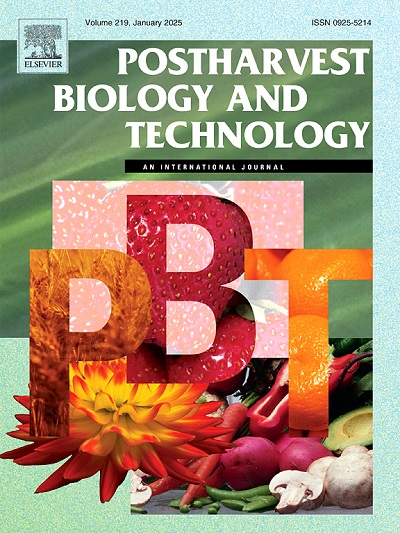采后乙醇蒸汽处理可减少美德枣的真菌量
IF 6.8
1区 农林科学
Q1 AGRONOMY
引用次数: 0
摘要
中枣的需求量很大,但微生物负荷水平可能超过一些国家规定的阈值。因此,我们的目标是找出在不影响质量的情况下,减少收获后中枣的微生物含量的方法。从同一个果园采摘两季后,或从包装厂储存 6 个月后,获得美德椰枣。用乙醇蒸汽、过氧化氢冷等离子体和过乙酸商业配方处理椰枣,并在 0°C 下储存 1 个月或在 -18°C 下储存 6 个月。在所有实验中,用乙醇蒸汽处理 20 小时后,真菌数量至少减少了 2 个数量级,但对细菌数量的影响较小。乙醇蒸汽处理在零下 18 摄氏度储存 6 个月后同样有效。用过氧化氢处理可减少细菌量,但有可能造成皮肤损伤。测得的外部微生物量和总微生物量水平相似,这表明外部污染在无症状水果中占主导地位。对红枣组织中微生物 DNA 的测序表明,在保质期后,曲霉菌是主要的真菌属,而芽孢杆菌是主要的细菌属。乙醇蒸汽处理改变了椰枣的挥发性,但对其风味没有明显影响。乙醇蒸汽处理是减少收获后相关系统中微生物负荷的有用工具。本文章由计算机程序翻译,如有差异,请以英文原文为准。
Postharvest ethanol vapor treatment reduces fungal load of Medjool dates
Medjool dates are in high demand but the level of microbial load can exceed thresholds set by some countries. The objective was therefore to identify methods to reduce the microbial load of Medjool dates after harvest without compromising its quality. Medjool dates were obtained after harvest from the same orchard over 2 seasons or from a packing house after 6 month of storage. The dates were treated with ethanol vapor, cold-plasma applicator of hydrogen peroxide and a commercial formulation of peracetic acid and stored at 0°C for one month or −18°C for 6 month. In all experiments, treatment with ethanol vapor for 20 hours reduced fungal load by at least 2 orders of magnitude but had lower efficacy with respect to bacterial load. The ethanol vapor treatment was also effective when carried out after 6 month of storage at −18°C. Treatment with hydrogen peroxide reduced bacterial load but showed potential for skin damage. Similar levels of external and total microbial load were measured suggesting that external contamination was dominant in asymptomatic fruit. Sequencing of microbial DNA from the date tissue showed that Aspergillus was the predominant fungal genus while Bacillus was the dominant bacterial genus after shelf life. The treatment with ethanol vapor changed the volatile profile of the dates but did not have an apparent influence of their flavor. The ethanol vapor treatment can be a useful tool to reduce microbial load in relevant postharvest systems.
求助全文
通过发布文献求助,成功后即可免费获取论文全文。
去求助
来源期刊

Postharvest Biology and Technology
农林科学-农艺学
CiteScore
12.00
自引率
11.40%
发文量
309
审稿时长
38 days
期刊介绍:
The journal is devoted exclusively to the publication of original papers, review articles and frontiers articles on biological and technological postharvest research. This includes the areas of postharvest storage, treatments and underpinning mechanisms, quality evaluation, packaging, handling and distribution of fresh horticultural crops including fruit, vegetables, flowers and nuts, but excluding grains, seeds and forages.
Papers reporting novel insights from fundamental and interdisciplinary research will be particularly encouraged. These disciplines include systems biology, bioinformatics, entomology, plant physiology, plant pathology, (bio)chemistry, engineering, modelling, and technologies for nondestructive testing.
Manuscripts on fresh food crops that will be further processed after postharvest storage, or on food processes beyond refrigeration, packaging and minimal processing will not be considered.
 求助内容:
求助内容: 应助结果提醒方式:
应助结果提醒方式:


